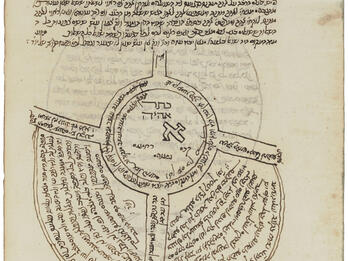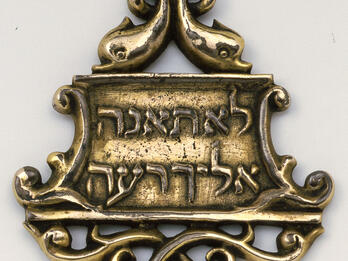Sha‘ar ha-yiḥudim (The Gate of Unifications)
First Unity
If you prostrate yourself over the graves of the righteous, you need to have the proper intention, so that through your prostration, you will cause the soul of that righteous person to prostrate itself and to be disseminated within his corpse. Then his corpse will be like a body for the soul that is disseminated within it and which remains in the grave. And then it will be as if he is in body and in soul. And indeed, if you do this within the first four hours of the day—when it is still the time of the recital of the Shema‘—you should recite the Shema‘ according to the bedtime version that I have given to you, as it cancels out the impure powers that surround man, and in particular those created by the wasteful spilling of seed, or a nocturnal emission. You should intend for this unity to be achieved through that [deceased] righteous man,1 and intend to make three times resh-yod-vav2 into one in the unity of the recital of the Shema‘, in order to make binah3 into a tool for the secret of that spirit, which is one resh-yod-vav. Likewise [in the second sentence in the recital of the Shema‘]: “Blessed is the Name of His glorious kingdom [malkhuto] for all eternity,” [a unity takes place] by way of the lower resh-yod-vav of malkhut,4 and the one is by way of the Torah and the commandments in the secret of the female waters of binah. Then the soul of that righteous man will be included in it, and your soul with him, through your giving of yourself over to the sanctification of the Name (kiddush ha-shem). Also, through the second coupling5 you should ask your question with the proper intention of “Blessed is the Name of His glorious kingdom for all eternity,” you should intend to raise the soul of that [deceased] righteous man and your soul together with him to the feminine waters of Malkhut, through the secret of “falling on the face” (nefilat apayim [Psalms 6:2–11, recited in the taḥanun prayers]). Then intend your question, and if it is not the time of the recital of the Shema‘, have intention for unity in your thought, without the coupling of the Shema‘ and “Blessed is the Name, etc.” And you should have it all in your thoughts. And indeed, know that all the unifications in the world require the proper intention for the rising up of your soul and the soul of the righteous man; you must intend that you and that righteous man, in your common root, are dependent upon the first man,6 as is written in the second unity; and indeed, these matters require great purity.
Notes
[Lurianic kabbalah emphasizes the divine connection at the graves of tzadikim, righteous souls, such as R. Simeon bar Yoḥai, to serve as conduits between the upper and lower realms.—Trans.]
[Resh-yod-vav holds the numerological value of 216, an important value in kabbalah stemming from three-times God’s seventy-two-letter name, which is based upon the three successive verses of Exodus 14:19–21 that contain seventy-two letters. In Lurianic kabbalah, the tetragrammaton (yod-heh-vav-heh) represents three times resh-yod-vav. The idea is to have the proper intention of combining these three into one in the Shema‘, affirming the ultimate Oneness of God’s name.—Trans.]
[Binah, the third sefirah, holds the numerological value of seventy-two and is the uppermost mother.—Trans.]
[Malkhut, the last sefirah, is the lower kabbalistic mother from which souls emerge into the physical world.—Trans.]
[Zivug, coupling, is the kabbalistic notion of creating a unity between the masculine and feminine aspects of God that enables divine emanation into the lower world.—Trans.]
[All humans have a common root in Adam, and thus are all related, and in essence, are united with each other.—Trans.]
Credits
Isaac Luria, “Shaʻar ha-yiḥudim (The Gate of Unifications)” (manuscript, Safed, second half of the 16th century). Published as: Ḥayyim ben Joseph Vital, Shaʻar ha-yiḥudim: Tsadik yesod ʻolam: U-ferush shirim shel shabat [Meha-Ari] (Lvov: M. F. Poremba, 1855).
Published in: The Posen Library of Jewish Culture and Civilization, vol. 5.




